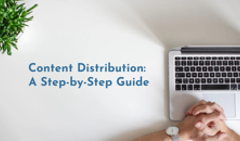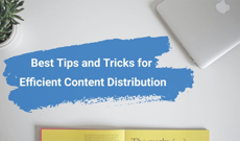In our daily lives, we come across various forms of text such as articles, social media posts, videos on YouTube, and so on. With so much information available, even high-quality work can easily get lost in the noise. The key to success is to create great content that not only appeals to your customers but also reaches your target audience.
So, how to make your content work? Choose the right content marketing distribution channels. And we’re here to help! In our article, we’ve covered the most common content distribution platforms, their specifics, and how you can benefit from using them.
What is Content Distribution?
Content distribution is the process of sharing and promoting your content to the target audience via various content marketing channels. There are three types of such channels, namely, owned media, earned media, and paid media. You can use one of these marketing channels or all of them to maximize their effectiveness and reach your company’s goals.
It is important to understand the pros and cons of different content distribution channels to create a successful content marketing strategy. After deciding on the strategy, you can move on and promote your content. By using different marketing channels, you can improve brand awareness, get new leads, expand your audience, and build a strong online presence.
What are Content Marketing Channels?
Content marketing channels are the channels through which you share and promote the content you create. The set of distribution channels will vary depending on your audience and resources. To get the most from your content marketing efforts, you need to choose the right digital marketing channels that will work for you. Each channel has its characteristics, focusing on different ways of sharing your content.
- Owned channels are the ones that belong to you, such as your website, blog, social media accounts, email newsletters, ebooks, or even your mobile app. You have full control over the content published on these marketing channels.
- Earned channels are the ones where others share your content. These are also referred to as shared channels. Examples of earned channels are guest posts and press releases. The key point of these channels is that anyone who shares your content does it for free—hence the name ‘earned’.
- Paid channels require payment and typically include pay-per-click (PPC) advertising, sponsored content, paid influencer content, and social ads. These digital marketing channels require careful consideration, planning, budgeting, and understanding of SEO strategies.
Content Types for Distribution
To effectively distribute your content, it is essential not only to choose content distribution channels that would work for you, but also to diversify the formats you use. Different types of content offer unique benefits and can be used to attract various audiences.
For instance, visual content such as videos and infographics may be more effective in catching the eye of social media users, while thought leadership articles and case studies will work better for B2B audiences. Expanding your content formats can increase reach and engagement, leading to more traffic and sales.
Content can take various forms, such as:
- How-to guides or other long-form content
- Newsletters
- Infographics
- E-books
- Podcasts
- White papers and reports
- Videos
- Case studies, or stories of success
- Polls
- Quizzes
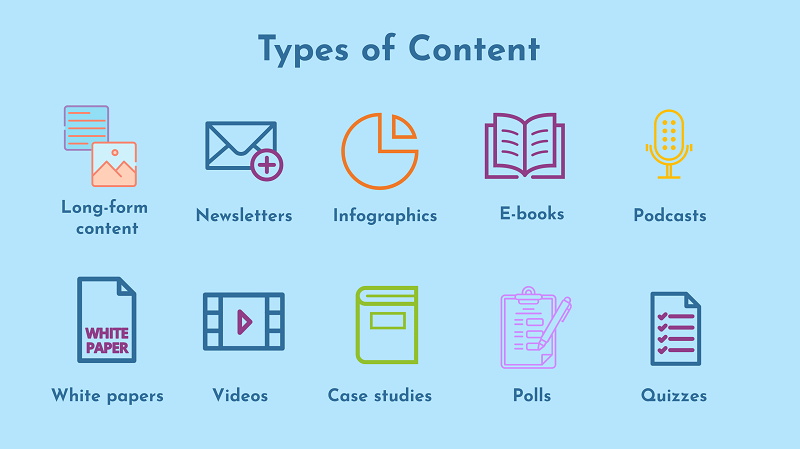
Now, let's look into 15 different content marketing channels, ranging from ebooks to paid advertising, and learn the most effective strategies for driving traffic from each of them to your website. By implementing these best practices, you can significantly enhance the impact of your content marketing initiatives and boost your online presence.
Owned Channels: Maximize Your Online Content Distribution
Owned marketing channels tend to be the simplest form of distribution, as they require less effort. However, companies produce a lot of content, and it becomes challenging to stand out from the crowd. How to attract readers and engage them in a way that will lead to more conversions? Let’s explore the best ways to do it.
#1 Website and blog
Typically, your website is the first thing people see. It provides information about your brand and values, and also serves as the primary point of contact with your online audience. That is why it's a highly effective channel for sharing your content.
Regularly posting case studies, in-depth articles, and other types of content on your website can significantly boost traffic and user engagement. You can also focus on distributing branded content that resonates with your target audience. The main purpose of sharing such content is to create a meaningful connection between your brand and its customers, providing value beyond just the product itself, and building a strong brand image. This approach can help you improve brand perception and establish an emotional connection with your audience.
# Ebooks
Ebooks are an excellent way to distribute content and engage with your readers. Recent research suggests that creating comprehensive and in-depth content can help your pages rank higher in Google, making it valuable for both readers and your website's SEO. By providing insightful information on a subject that interests your audience, you can demonstrate your reliability and increase brand awareness.
You can use various formats to publish your ebook: a downloadable PDF, a digital interactive ebook, or publish it on ebook platforms. If you decide to move on with an interactive digital format, check out the benefits that you’ll get:
✅ Multichannel sharing. Send a digital ebook as a link, as an embed, or as a preview on social media.
✅ Interactive elements. Enrich your ebook with videos, GIFs, and pop-up images.
✅ Branding. Wrap your content in your custom branding: from your own background and color palette down to your company logo.
✅ Built-in lead capture form. Capture leads and collect valuable information such as prospect emails, names, and phone numbers.
✅ Ebook analytics. Analyze how your content performs: see the number of views, unique visitors, shares, and interactions with your ebook.
✅ Content protection. You can choose in ebook settings whether you want it to be Google-indexed and show up in search results or to gate it with a password.
See for yourself, flip through this interactive ebook with GIFs, videos, and pop-ups. It’s enhanced with eye-catching GIFs and a moving page corner. Your readers will be interested in flipping through the pages to discover more.
6 Reasons to Make a PDF Interactive
#3 Email newsletters
Email newsletters are an excellent way to distribute content to an established audience. Engaging newsletters can help you build a good relationship with your clients by promoting new products or services, or directing them through the content to other channels to increase engagement. Whether you send emails manually or use third-party services to deliver emails, it’s a direct way to share information and news with those who are already familiar with your brand.
Sending a curiosity-generating email about new content on your site is a proven way to boost sales and improve search engine ranking. Email newsletters are a well-established method of educating and staying in touch with your customer base.
#4 Social media platforms
Social media channels are among the most obvious ways of content distribution. No need to mention that every company now has social media profiles on Facebook, X, LinkedIn, Instagram, and other media to engage with their audience, share content, and increase brand awareness.
By publishing your content on Facebook and other social media, you can cultivate a loyal customer base and expand market reach. With proper planning and management, this can be achieved at a low cost to the business itself.
Don’t forget that each social media platform has a different format, so you need to customize your content for each social media to maximize its impact, taking into account differences in content type, presentation, and format.
#5 Video
Video content has become an essential part of our lives. It's hard to imagine a day without watching a video, whether it's related to work or just for fun.
Every day, around 100 million people watch videos online. You can leverage this opportunity by repurposing your existing posts into videos. Make sure to incorporate call-to-action text in your videos to encourage your target audience to visit your website. This is an excellent opportunity to expand your reach and attract new customers.
When it comes to the distribution of video content, platforms like Vimeo and YouTube make it easy. Keep these basic recommendations in mind when creating videos:
📹 Define your goals: what you want to show in the video and what the main concept will be.
📹 Choose the type of your video: product review, tutorial, brand film, or something else.
📹 Think about the format in advance: each social media platform has specific requirements or limitations for a video. They can be technical, such as video quality, or refer to the video’s size and duration.
📹 Optimize for mobile devices: according to stats, mobile video is the way to go. Just imagine: 3.5 billion users watched videos on mobile devices in 2023. Video popularity also applies to Instagram: over 70% of Instagram users watch video content in the form of Stories daily.
What’s more, you can go further and combine different content formats. For example, add video to your ebook. Thus, you will increase engagement, conversion, and also enhance the viewing experience.
6 Reasons to Make a PDF Interactive
#6 Infographics
Infographics are a popular form of visual content that can be easily shared, making them an excellent way to distribute your content. There are many tools and platforms you can use to create infographics that will entertain your readers. Infographics are loved by readers because they are easy to understand, digest, and are packed with valuable information.
One way to create infographics is by basing them on published articles. You can share statistics on the topic you have written about and make your content even more unique. Infographics also work well on social media, particularly X and LinkedIn, because they are easily consumable as you scroll through your newsfeed. Also, you can create animated infographics to engage your target audience.
Infographics can also help you make statistics readable, as they can be hard to understand and remember otherwise. With infographics, you can turn numbers into pictures that are easy to process, remember, and visualize.
Earned Channels: Get Your Content Promoted on Other Sites
Being promoted and recommended through earned media is one of the hardest things to achieve—though the most valuable due to its credibility and potential reach. Whether your content is shared by users or by brands, it will help your business thrive. While it requires a lot of effort from you, the amount of trust placed in these recommendations is huge.
#7 Guest blogging
Although there are some myths about guest blogging being ineffective, it is an efficient way to distribute content. It allows you to reach a wider audience and increase brand awareness. Additionally, guest blogging can help you establish strong long-term partnerships with industry experts.
To achieve the best results from guest blogging, focus on authoritative websites that are related to your niche and content topics. Pitch your idea and start a collaboration. If utilized in the right way, this content distribution channel can help you generate qualified leads, increase mentions about your company, and boost referral traffic to your website.
#8 Press releases
Got something newsworthy to share? Consider writing a press release. It’s a great way to share your company news and updates with wide audiences and get promoted. You can either hire a PR firm or publish a press release yourself through a paid press release distribution network like PR Newswire.
PR Newswire is a paid press release distribution network. Via this channel, you can publish a press release about your company’s news, announcements, and events to various sources and audiences, across specific industries, geographic locations, and more.
Keep in mind that press releases work great if you’re launching new products/services, supporting a large cause, or changing your brand name. This channel won’t work if you want to promote your regular marketing posts.
#9 QA Platforms
QA platforms such as Quora and Reddit can give you a great boost in content shares. People search for answers, so why not give them yours and refer to your content? But keep in mind that this way of distributing content needs time and effort.
The main idea behind Quora is that people can ask their own questions and answer those of others. The website has different categories—choose the ones where you can give an insightful response. Add a link to your website pages related to the answer you’ve posted and, if possible, to an authoritative source. Give varied, human answers to increase the authenticity and transparency of your brand. If people like your answers, they’re likely to share them on their pages or other resources. Don’t post similar, repetitive answers as it will show your profile as unreliable and violate the platform’s rules.
Reddit, another QA platform, is a bit difficult for new users because the site is quite complex. Registered members can submit content to the site, which is then voted up or down by other members. Posts are organized by subject into user-created boards called subreddits. They cover a variety of topics from news to photos of pets. Reddit allows you to add images and links to your answers but you have to be careful with that—only highly relevant links will be clicked. Irrelevant answers will be downvoted and marked as spam. However, if you receive positive votes for your answer, your post will become more significant and will bring people to your website.
By using QA platforms, you provide more information about your brand to your target audience and improve your credibility.
#10 Online platforms
Online platforms attract some of the world's most insightful writers, thinkers, and storytellers. Websites like Medium and Haro can be a great way to promote your content.
Medium is a platform where you can publish your content as an individual contributor or as a company. You can either create standalone articles there or run something similar to a blog on your site. But to give your content the broadest reach we recommend using Medium as an addition to your blog. The platform has thousands of readers every day and a good SEO rating, so your content will be seen by a lot of people.
Another tool to distribute your content can be HARO. It’s an online platform that connects people and companies. You can register as a journalist if you’re conducting some research and gather information about a specific topic. This information from industry experts will become a great foundation for your next article and provide you with valuable insights. And if you want to answer questions and then be quoted in different articles, then get registered as a source. In any case, HARO is a great content distribution channel and helps to get press mentions and backlinks.
#11 Podcasts
Just a decade ago podcasts weren’t as popular as they are nowadays. Stats show that there are over 500,000 active podcasts and more than 70 million podcast episodes.
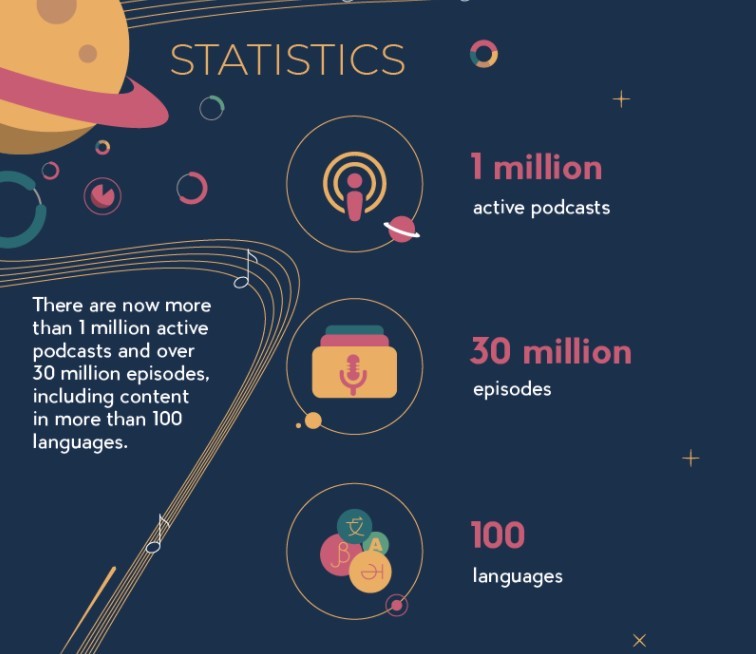
Source: Musicoomph
A podcast is a series of recorded audio content released regularly in the form of episodes. The channel has been growing rapidly in the recent years. Here are four benefits of podcasts as a content distribution channel:
✅ Podcasts are on-trend. According to stats, approximately 165 million people have listened to a podcast—it’s over 42% of the US population.
✅ Ease of creation. To record a podcast you don’t need special training. You can get started with inexpensive equipment to record audio and make sure it sounds good by using simple online tools.
✅ Potential of using content multiple times. Let’s say, you record an interview with an expert. Why not repurpose it? You can use it in your podcast first, then publish it on the blog and also make a video.
✅ Participating in podcasts. You can not only invite experts to your podcast but also attend some yourself. This allows you to reach a new audience and spread your content more easily.
Paid Channels: Pay to Get Your Content Seen
Paid content distribution is an effective way to increase your reach and drive more traffic to your website in a relatively short period of time. This can be done through targeted social media advertising, native advertising, and sponsored content. By paying to target high-potential audiences, your business can gain more exposure and generate leads beyond owned and earned channels.
#12 Pay-per-click (PPC) advertising
Pay-per-click (PPC) requires payment each time an online user clicks on an ad or a link. This way, the advertiser pays when users interact with ads. PPC is paired with an SEO strategy, and, if done right, it can bring quality leads.
One of the most common types of PPC is ads in search engines—most commonly in Google. That’s why you’ll need the Google Ads platform to publish your ads. Search ads require specific keywords applicable to your target audience, engaging content, and strong CTA text to entice users to click. Don’t forget to determine keywords that match your content strategy, target audience, and your brand. The more accurate and relevant your ads are, the better results you’ll get for your efforts.
#13 Paid influencer marketing
Influencer marketing refers to employing leading content creators in your business niche to promote your brand. Influencers tell people about your brand and share their personal experience with it. This helps increase brand awareness, boost traffic to your website, and deliver your content to the target audience. Influencer marketing can drive your brand’s message across various channels and not only reach your target audience but also expand it and drive new leads. Since people mostly believe reliable brands, influencer marketing is gaining popularity: customers would rather trust people they already admire than companies selling products and services they may or may not use.
You can use different channels to find influencers in your niche. Firstly, define where your target audience spends most of their time. Based on this information, you can choose influencers from social networks, blogs, or other media. If you’re struggling with the search, take a look at your peers: the influencers they’ve partnered with might work for you too.
#14 Sponsored content
Sponsored content is a type of promotional media that's paid by the advertiser, but created and shared by another brand, influencer, or publisher.
Sponsored content makes your brand look more trustworthy and engages potential customers. It can be shared by a person or brand and includes all types of media: images, videos, podcasts, and more. To make this content distribution channel work well for you, find influencers who target the same audience as you and share topics related to your niche or brand in their accounts. Why? Because your content or a mention of your brand will fit right in and look natural, unlike the annoying advertisements we see daily. For instance, sponsored content on Instagram may look like a regular post with a hashtag #sponsored or a mention that it’s a paid partnership.

Source: my.blessed.home
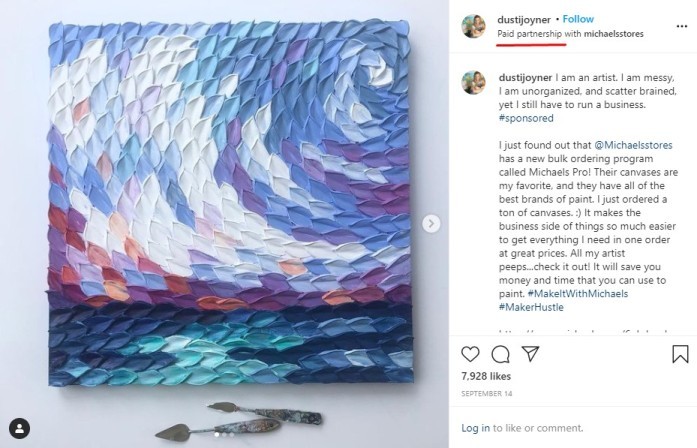
Source: dustijoyner
#15 Paid social ads
At first glance, this channel may resemble sponsored content. However, these two content distribution channels have crucial differences. While sponsored content is seen only by those who follow a specific account, paid advertisements can pop up in anybody’s newsfeed.
Paid social media include advertisements or sponsored content published on popular social media platforms and targeted at a specific audience. This channel can include PPC advertising, branded or influencer-generated content, and sponsored content. The form of the content will vary depending on the platform where it’s shared. For example, Instagram focuses on visual content, while LinkedIn is a better fit for texts, in-depth research, stats. So, you’ll need to adjust your content distribution strategy to each social media platform.
5 Quick Tips for Successful Content Distribution
Creating high-quality content is a key component for successful content distribution. You must avoid distributing boring or unoriginal content that doesn't offer any unique value to the audience. Also, good content will be more attractive to third-party platforms and publishers and will naturally attract more earned media exposure.
📱 Optimize for mobile viewing
It’s no secret that a lot of web traffic comes to smartphones. Therefore, when creating your content, ensure that it’s mobile-friendly and easy to access on various devices. For instance, you can use larger fonts, a single-column layout, an interactive table of contents to make navigation through the document easier, and other improvements.
🤝Collaborate with influencers
Partner with social media influencers and thought leaders in your industry to expand your reach and tap into new audiences. Influencers can share your content with their followers, increasing your brand’s exposure and credibility.
📱Leverage user-generated content
User-generated content (UGC) is the most trusted content online. Encourage customers to create and share their content, such as product reviews or testimonials. UGC is seen as more ‘authentic’ and is therefore more likely to engage readers.
📖 Experiment with different content types
Create a variety of content for a range of channels to keep your audience engaged and attract new followers. Diversify! Consider blog posts, videos, podcasts, infographics, ebooks, thought leadership articles, case studies, white papers, social media posts, and more.
📈 Consistently monitor and analyze performance
Use tools like Google Analytics, Moz, Ahrefs, and others for social media analytics. These tools provide businesses with a clear understanding of the overall effectiveness of their content distribution strategy. Analyze your content performance metrics regularly to proactively implement changes.
Distribute Your Content Effectively
Crafting high-quality content is just the beginning of a journey towards effective communication. To make sure your message reaches your target audience and engages them, you need to leverage content distribution channels. By choosing the right channels, you can increase your brand's visibility, attract loyal followers, and inspire readers to take action and become your customers.


